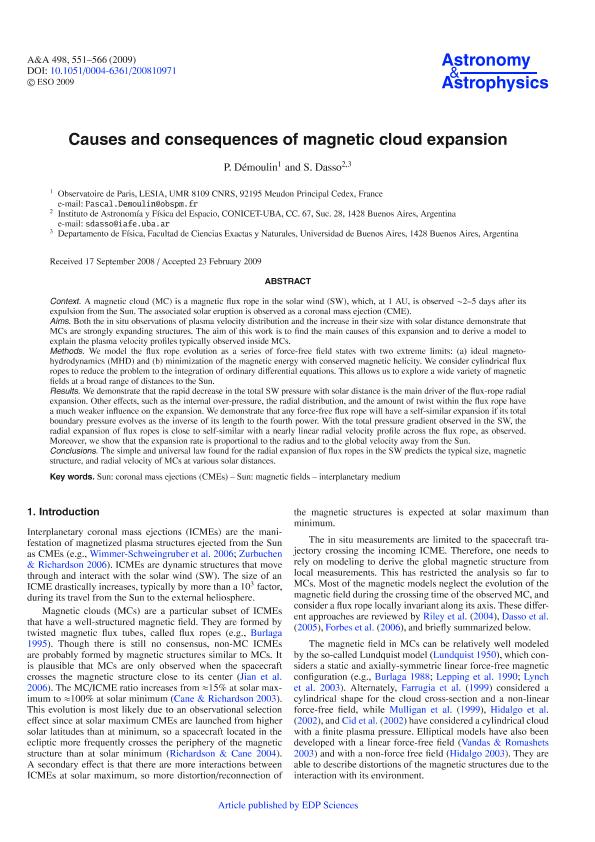Mostrar el registro sencillo del ítem
dc.contributor.author
Démoulin, Pascal

dc.contributor.author
Dasso, Sergio Ricardo

dc.date.available
2017-07-14T17:20:11Z
dc.date.issued
2009-12
dc.identifier.citation
Démoulin, Pascal; Dasso, Sergio Ricardo; Causes and Consequences of Magnetic Cloud Expansion; EDP Sciences; Astronomy and Astrophysics; 498; 2; 12-2009; 551-566
dc.identifier.issn
0004-6361
dc.identifier.uri
http://hdl.handle.net/11336/20582
dc.description.abstract
Context. A magnetic cloud (MC) is a magnetic flux rope in the solar wind (SW), Which, at 1 AU, is observed ∼2–5 days after its expulsion from the Sun. The associated solar eruption is observed as a coronal mass ejection (CME). Aims. Both the in situ observations of plasma velocity distribution and the increase in their size with solar distance demonstrate that MCs are strongly expanding structures. The aim of this work is to find the main causes of this expansion and to derive a model to explain the plasma velocity profiles typically observed inside MCs. Methods. We model the flux rope evolution as a series of force-free field states with two extreme limits: (a) ideal magnetohydrodynamics (MHD) and (b) minimization of the magnetic energy with conserved magnetic helicity. We consider cylindrical flux ropes to reduce the problem to the integration of ordinary differential equations. This allows us to explore a wide variety of magnetic fields at a broad range of distances to the Sun. Results. We demonstrate that the rapid decrease in the total SW pressure with solar distance is the main driver of the flux-rope radial expansion. Other effects, such as the internal over-pressure, the radial distribution, and the amount of twist within the flux rope have a much weaker influence on the expansion. We demonstrate that any force-free flux rope will have a self-similar expansion if its total
boundary pressure evolves as the inverse of its length to the fourth power. With the total pressure gradient observed in the SW, the radial expansion of flux ropes is close to self-similar with a nearly linear radial velocity profile across the flux rope, as observed. Moreover, we show that the expansion rate is proportional to the radius and to the global velocity away from the Sun. Conclusions. The simple and universal law found for the radial expansion of flux ropes in the SW predicts the typical size, magnetic structure, and radial velocity of MCs at various solar distances.
dc.format
application/pdf
dc.language.iso
eng
dc.publisher
EDP Sciences

dc.rights
info:eu-repo/semantics/openAccess
dc.rights.uri
https://creativecommons.org/licenses/by-nc-sa/2.5/ar/
dc.subject
Solar Wind
dc.subject
Magnetic Field
dc.subject.classification
Astronomía

dc.subject.classification
Ciencias Físicas

dc.subject.classification
CIENCIAS NATURALES Y EXACTAS

dc.title
Causes and Consequences of Magnetic Cloud Expansion
dc.type
info:eu-repo/semantics/article
dc.type
info:ar-repo/semantics/artículo
dc.type
info:eu-repo/semantics/publishedVersion
dc.date.updated
2017-07-14T14:08:05Z
dc.journal.volume
498
dc.journal.number
2
dc.journal.pagination
551-566
dc.journal.pais
Francia

dc.journal.ciudad
Paris
dc.description.fil
Fil: Démoulin, Pascal. Centre National de la Recherche Scientifique. Observatoire de Paris; Francia
dc.description.fil
Fil: Dasso, Sergio Ricardo. Consejo Nacional de Investigaciónes Científicas y Técnicas. Oficina de Coordinación Administrativa Ciudad Universitaria. Instituto de Astronomía y Física del Espacio. - Universidad de Buenos Aires. Facultad de Ciencias Exactas y Naturales. Instituto de Astronomía y Física del Espacio; Argentina
dc.journal.title
Astronomy and Astrophysics

dc.relation.alternativeid
info:eu-repo/semantics/altIdentifier/doi/http://dx.doi.org/10.1051/0004-6361/200810971
dc.relation.alternativeid
info:eu-repo/semantics/altIdentifier/url/https://www.aanda.org/articles/aa/abs/2009/17/aa10971-08/aa10971-08.html
Archivos asociados
